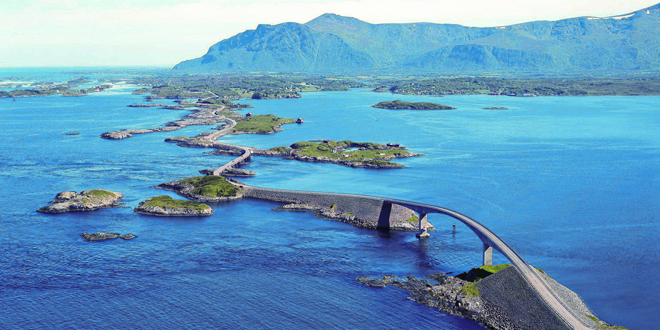Carretera sobre el Atlàntico
English Español
Atlantic Ocean Road
The Atlantic Ocean Road or
the Atlantic Road (Norwegian) is an 8.3-kilometer (5.2 mi)
long section of County Road 64 that runs through an archipelago
in Eide
and Averøy
in Møre og Romsdal, Norway.
It passes by Hustadvika, an unsheltered part of the Norwegian Sea,
connecting the island of Averøy with the mainland and Romsdalshalvøya peninsula. It runs between the
villages of Kårvåg on Averøy and Vevang
in Eida. It is built on several small islands and skerries,
which are connected by several causeways, viaducts and eight bridges—the most prominent being Storseisundet Bridge.
The route was originally proposed
as a railway line in the early 20th century, but this was abandoned. Serious
planning of the road started in the 1970s, and construction started on 1 August
1983. During construction the area was hit by 12 European windstorms. The road was opened on 7
July 1989, having cost 122 million Norwegian
krone (NOK), of which 25 percent was financed with tolls
and the rest from public grants. Collection of tolls was scheduled to run for
15 years, but by June 1999 the road was paid off and the toll removed. The road
is preserved as a cultural heritage site and is classified as a National Tourist Route. It
is a popular site to film automotive commercials, has been declared the world's
best road trip, and been awarded the title as "Norwegian Construction of
the Century". In 2009, the Atlantic Ocean Tunnel opened from Averøy
to Kristiansund;
together they form a second fixed link between Kristiansund and Molde.
Route
description
The road is a 8.274-kilometer (5.141 mi) long section of County Road
64 that connects the island and municipality of Averøy with the mainland at
Eide. The road runs across an archipelago of partially inhabited islands and
skerries.To the north lies Hustadvika, an unsheltered section of the Norwegian
Sea, to the south Lauvøyfjorden.The road has
a width of 6.5 meters (21 ft) and a maximum gradient of eight percent. It consists of eight bridges and four resting
places and viewpoints. Several tourist sites, including dining, fishing and
scuba diving resorts, have been established on the islands.
The road begins at Utheim on Averøy, close to the village of Kårvåg. It
runs onto the island of Kuholmen and then across the 115-meter (377 ft)
long Little Lauvøysund Bridge onto the island of Lille Lauvøy. It continues
across the 52-meter (171 ft) long Store Lauvholmen Bridge onto Store Lauvøy. Next it
crosses the equally long Geitøysund Bridge to Geitøya, which features a viewpoint and
parking. It then runs across Eldhusøya and Lyngholmen, before
reaching Ildhusøya, where there are
a resting place, parking and a viewpoint. Next is Storseisundet Bridge, a cantilever
bridge 260 meters (850 ft) long. The municipal boundary between
Eide and Averøy runs under the bridge. It then runs across Flatskjæret, where
there is a viewpoint, before crossing onto Hulvågen via the three Hulvågen
Bridges, which combined are 293-meter (961 ft)SkarvøyStrømsholmenThe route
reaches the mainland over the 119-meter (390 ft) long Vevangstraumen
Bridge.
History
The first proposals to use the
route were made in the early 20th century. Planning of the Rauma Line
to connect the national railway network to møre og
Romsdal was under way, and several proposals were made to extend it to the
coastal towns. In 1921, Møre og Romsdal County Council
chose the outer route, which would have followed a path close to that of the
road. The Rauma Line was not built beyond Åndalsnes,
and in 1935 the Parliament of Norway decided to connect
the coastal towns in Møre og Romsdal to Åndalsnes by road instead of rail.
Comentarios
Publicar un comentario